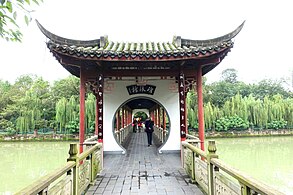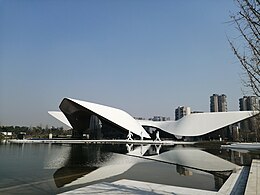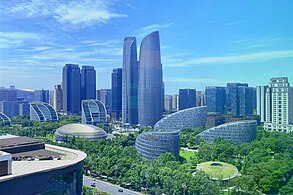
Chengdu
Chengdu[a] is the capital city of the Chinese province of Sichuan. With a population of 20,937,757 at the 2020 Census,[7] it is the fourth most populous city in China, and it is the only city with a population of over 20 million apart from direct-administered municipalities. It is traditionally the hub of Western China.
Chengdu
成都Chentu, Ch'en-tu, Chengtu, Ch'eng-tu
12 districts, 5 county-level cities, 3 counties
Zhang Shan
14,378.18 km2 (5,551.45 sq mi)
3,679.9 km2 (1,420.8 sq mi)
4,558.8 km2 (1,760.2 sq mi)
465.88 km2 (179.88 sq mi)
500 m (1,600 ft)
5,364 m (17,598 ft)
378 m (1,240 ft)
20,937,757
1,500/km2 (3,800/sq mi)
15,419,445
4,200/km2 (11,000/sq mi)
16,045,577
3,500/km2 (9,100/sq mi)
CN¥ 97,893
US$ 14,557
川A and 川G
Chéngdū
Chengtu
"The Established Capital City"
Chéngdū
Chéngdū
ㄔㄥˊ ㄉㄨ
Cherngdu
Chʻeng2-tu1
Chéngdu
- Cen2du1 (Sichuanese Pinyin)
- [tsʰən˨˩tu˥]
Zen3-tu1
Zén-tou
Sìhngdōu
sing4 dou1
Sêng-to͘
Western Capital
Xījīng
Xījīng
ㄒㄧ ㄐㄧㄥ
Shijing
Hsi1-ching1
Sijing
Syījīng
Brocade City
Jǐnchéng
Jǐnchéng
ㄐㄧㄣˇ ㄔㄥˊ
Jiincherng
Chin3-chʻeng2
Jǐnchéng
Hibiscus City
Róngchéng
Róngchéng
ㄖㄨㄥˊ ㄔㄥˊ
Rongcherng
Jung2-chʻeng2
Róngchéng
Chengdu is in central Sichuan. The surrounding Chengdu Plain is known as the "Country of Heaven"[b] and the "Land of Abundance." Its prehistoric settlers included the Sanxingdui culture. The site of Dujiangyan, an ancient irrigation system, is designated as a World Heritage Site.[8] The Jin River flows through the city. Chengdu's culture largely reflects that of its province, Sichuan; in 2011, it was recognized by UNESCO as a city of gastronomy.[9] It is associated with the giant panda, a Chinese national symbol, which inhabits the area of Sichuan; the city is home to the Chengdu Research Base of Giant Panda Breeding.
Founded by the Kingdom of Shu in 4th century BC, Chengdu is unique as the only major Chinese settlement that has maintained its name unchanged for more than two thousand years throughout the imperial, republican, and communist eras. It was the capital of Liu Bei's Shu Han Empire during the Three Kingdoms Era, as well as several other local kingdoms during the Middle Ages.[10] During World War II, refugees from eastern China fleeing from the Japanese settled in Chengdu. After the war, Chengdu was briefly the capital of the Nationalist republican government until it withdrew to Taipei on the island of Taiwan. Under the PRC, Chengdu's importance as a link between Eastern China and Western China expanded, with railways built to Chongqing in 1952, and Kunming and Tibet afterward.[10] In the 1960s, Chengdu became an important defense industry hub.
Chengdu is now one of the most important economic, financial, commercial, cultural, transportation, research and communication centers in China. Its economy is diverse, characterized by the machinery, automobile, medicine, food, and information technology industries. Chengdu is a leading financial hub, ranking 35th globally the 2021 Global Financial Centres Index.[11] Chengdu also hosts many international companies; more than 300 Fortune 500 companies have established branches in Chengdu.[12] Chengdu is the third Chinese city with two international airports after Beijing and Shanghai.[13] Chengdu Shuangliu International Airport, and the newly built Tianfu International Airport, a hub of Air China and Sichuan Airlines, is one of the 30 busiest airports in the world, and the Chengdu railway station is one of the six biggest in China. Chengdu is considered a "Beta + (global second-tier)" city classification (together with Barcelona and Washington, D.C.) according to the GaWC.[14] As of 2023, the city also hosts 23 foreign consulates, the fourth most in China behind Beijing, Shanghai, and Guangzhou.[15] Chengdu is the seat of the Western Theater Command region of the People's Liberation Army.[16] In 2023, Chengdu became the third Chinese city to host the 31st FISU Summer World University Games, after Beijing 2001 and Shenzhen 2011. Chengdu will also host the 2025 World Games. It is considered one of the best cities in China to live.[17][18] It is also a national central city of China.[19]
Chengdu is one of the world's top 25 cities by scientific research output,[20] and home to the greatest number of universities and research institutes in Western China, notably Sichuan University, University of Electronic Science and Technology of China, Southwestern University of Finance and Economics, Southwest Jiaotong University, Chengdu University of Technology, Sichuan Normal University, and Xihua University.[21]
Name[edit]
The name Chengdu is attested in sources dating back to the Warring States period. It has been called the only major city in China to have remained at an unchanged location with an unchanged name throughout the imperial, republican, and communist eras.[22] However, it also had other names; for example, it was briefly known as "Xijing" (Western Capital) in the 17th century.[23] Etymology of the name is unclear. The earliest and most widely known explanation, although not generally accepted by modern scholars,[24] is provided in the 10th-century geographical work Universal Geography of the Taiping Era, which states that the ninth king of Shu's Kaiming dynasty named his new capital Chengdu after a statement by King Tai of Zhou that a settlement needed "one year to become a town, two to become a city, and three to become a metropolis."[c][25] (The character for cheng 成 may mean "turned into" while du 都 can mean either a metropolis or a capital).
The present spelling is based on pinyin romanization; its Postal Map romanization was "Chengtu." Its former status as the seat of the Chengdu Prefecture prompted Marco Polo's spellings "Sindafu," "Sin-din-fu," &c.[26][27] and the Protestant missionaries' romanization "Ching-too Foo."[28]
Although the official name of the city has remained (almost) constant, the surrounding area has sometimes taken other names, including "Yizhou." Chinese nicknames for the city include the "Turtle City", variously derived from the old city walls' shape on a map or a legend that Zhang Yi had planned their course by following a turtle's tracks; the "Brocade City" (see Sichuan brocade), a contraction of the earlier "City of the Brocade Official," after an imperial office established under the Western Han; the "Hibiscus City" (Rongcheng, 蓉城), from the hibiscus which King Mengchang of the Later Shu ordered planted upon the city wall during the 10th century.[1][29][30]
According to Étienne de la Vaissière, "Baghshūr" (lit. 'pond of salt water') may be the Sogdian name for the region of Chengdu. This toponym is attested near Merv, but
not far from Chengdu are found the large salt water wells of the Yangtze basin.[31]
Logo[edit]
The city logo adopted in 2011 is inspired by the Golden Sun Bird, an ancient relic unearthed in 2001 from the Jinsha Site.[32]
Chengdu is a sub-provincial city[68] which has served as the capital of Sichuan since Chongqing's restoration to provincial status in 1997.[69] It has direct jurisdiction over 12 districts, 5 county-level cities and 3 counties:











